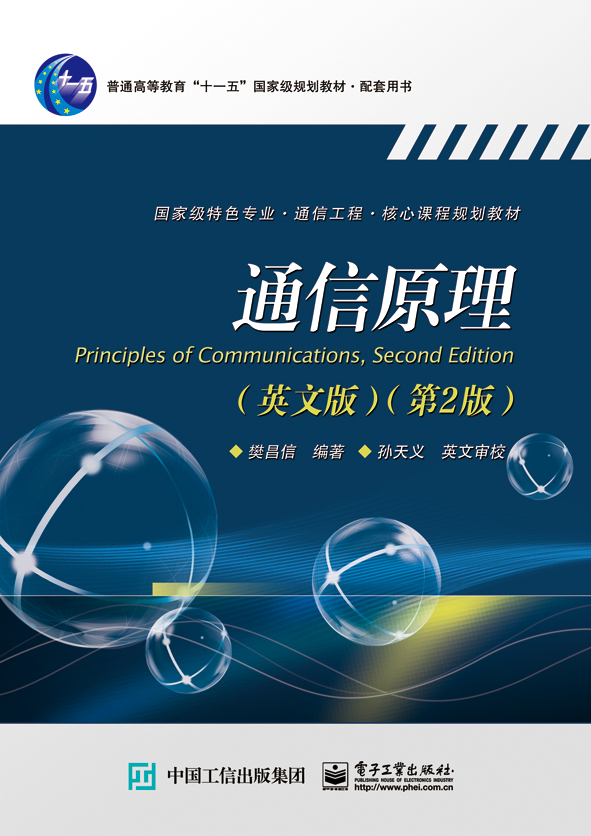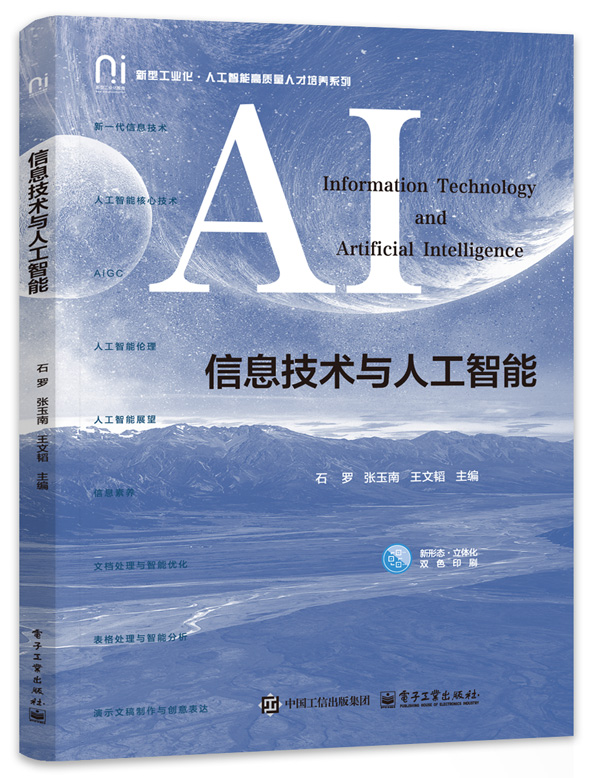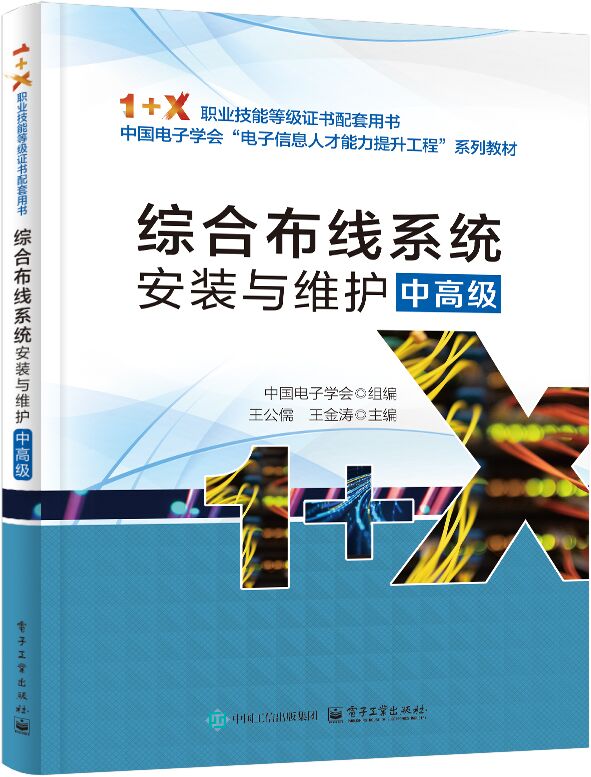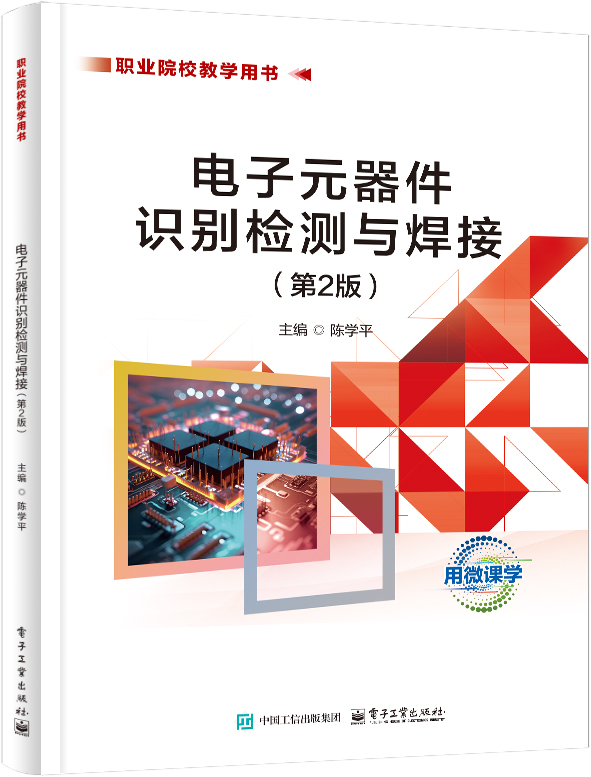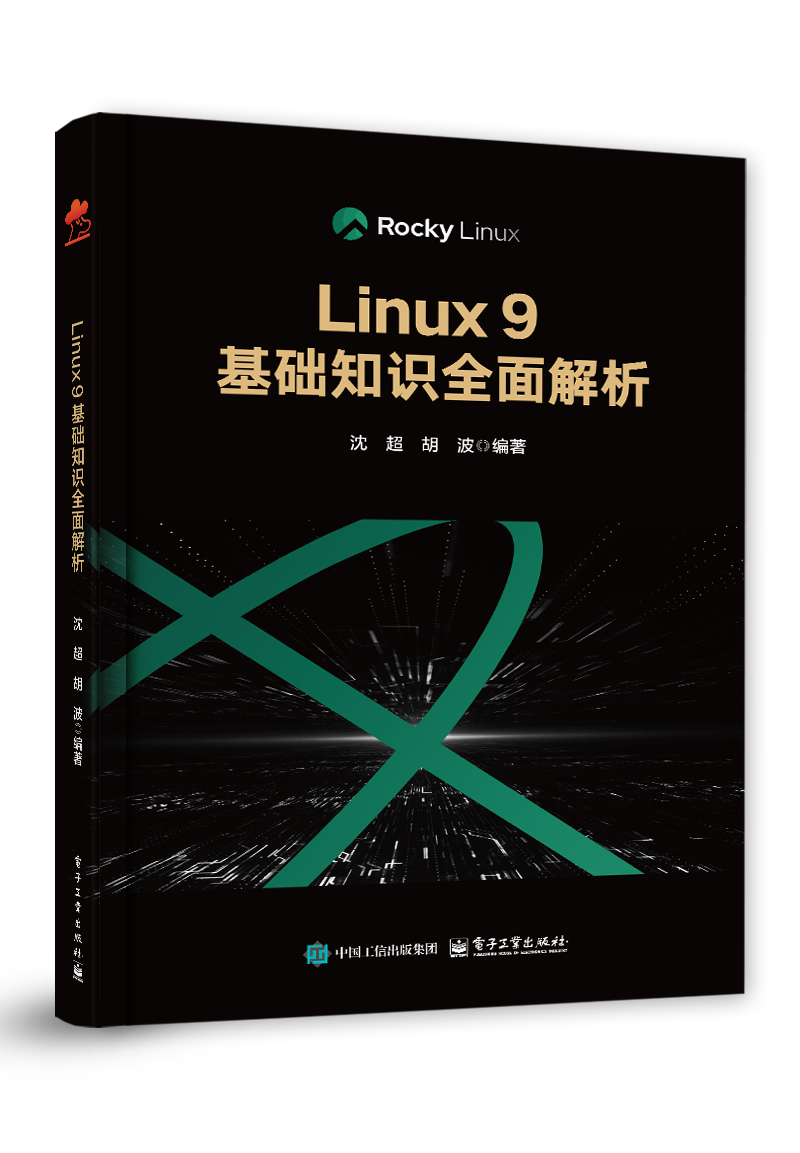通信原理(英文版)(第2版)
作 译 者:樊昌信
出 版 日 期:2015-08-01
书 代 号:G0264230
I S B N:9787121264238
图书简介:
The book is suitable for electronic specialties of engineering school in Chinese general institutions of higher learning as the textbook or reference for the junior and senior students and graduate students, and can also be used as a reference book or a textbook in the advanced study classes for the engineering and technical personnel engaged in communication engineering.
-
配 套 资 源
本书资源
-
图 书 内 容
内容简介
The book is suitable for electronic specialties of engineering school in Chinese general institutions of higher learning as the textbook or reference for the junior and senior students and graduate students, and can also be used as a reference book or a textbook in the advanced study classes for the engineering and technical personnel engaged in communication engineering.图书详情
ISBN:9787121264238开 本:16(185*260)页 数:432字 数:700.0本书目录
PARTⅠ Chapter 1Introduction 11Historical Review of Communication 12Message,Information,and Signal 13Digital Communication 131Basic Concept 132Advantages of Digital Communication 133Digital Communication System Model 134Specifications of Digital Communication System 14Channel 141Wireless Channel 142Wired Channel 143Channel Models 144Influence of Channel Characteristics on Signal Transmission 15Noise in Channel 16Brief Summary Questions Exercises Chapter 2Signals 21Classification of Signals 22Characteristics of Deterministic Signals 221Characteristics in Frequency Domain 222Characteristis in Time Domain 23Characteristics of Random Signals 231Probability Distribution of Random Variable 232Probability Density of Random Variable 24Examples of Frequently Used Random Variables 25Numerical Characteristics of Random Variable 251Mathematical Expectation 252Variance 253Moment 26Random Process 261Basic Concept of Random Process 262Stationary Random Process 263Ergodicity 264Autocorrelation Function and Power Spectral Density of Stationary Random Process 27Gaussian Process 28Narrow Band Random Process 281Basic Concept of Narrow Band Random Process 282Characteristics of Narrow Band Random Process 29Sinusoidal Wave plus Narrow Band Gaussian Process 210Signal Transfer through Linear Systems 2101Basic Concept of Linear Systems 2102Deterministic Signal Transfer through Linear Systems 2103Random Signal Transfer through Linear Systems 211Brief Summary Questions Exercises Chapter 3Analog Modulation System 31Introduction 32Linear Modulation 321Amplitude Modulation (AM) 322Doublesideband Modulation (DSB) 323SingleSideband Modulation (SSB) 324Vestigial Sideband Modulation (VSB) 33Nonlinear Modulation 331Basic Principles 332Frequency Spectrum and Bandwidth of Modulated Signal 333Reception of Angular Modulated Signal 34Brief Summary Questions Exercises Chapter 4Digitization of Analog Signal 41Introduction 42Sampling of Analog Signal 421Sampling of LowPass Analog Signal 422Sampling of BandPass Analog Signal 423Analog Pulse Modulation 43Quantization of Sampled Signal 431Principles of Quantization 432Uniform Quantization 433Nonuniform Quantization 44Pulse Code Modulation 441Basic Principles of Pulse Code Modulation 442Natural Binary Code and Fold Binary Code 443Quantization Noise in PCM System 45Differential Pulse Code Modulation 451Principles of Differential Pulse Code Modulation 452Quantization Noise and Signal to Quantization Noise Ratio in DPCM System 46Delta Modulation 461Principles of Delta Modulation 462Quantization Noise in Delta Modulation System 47Brief Summary Questions Exercises Chapter 5Representation and Transmission of Baseband Digital Signal 51Introduction 52Coding Method of Character 53Waveform of Baseband Digital Signal 54Symbol Code Types of Baseband Digital Signals for Transmission 55Frequency Characteristic of Baseband Digital Signal 551Calculation of Power Spectral Density of vc(t) 552Calculation of Power Spectral Density of uc(t) 553Calculation of Power Spectral Density of s(t) 554Examples of Power Spectral Density Calculation 56Transmission and Intersymbol Interference of Baseband Digital Signal 561Model of Baseband Digital Signal Transmission System 562Intersymbol Interference and Nyquist Criterion 563Partial Response System 57Eye Pattern 58Timedomain Equalizer 581Introduction 582Fundamental Principle of Transversal Filter 583Realization of Transversal Filter 59Brief Summary Questions Exercises Chapter 6Elementary Digital Modulation System 61Introduction 62Binary Amplitude Shift Keying (2ASK) 621Basic Principle 622Power Spectral Density 623Symbol Error Probability 63Binary Frequency Shift Keying (2FSK) 631Basic Principle 632Power Spectral Density 633Minimum Frequency Space 634Symbol Error Probability 64Binary Phase Shift Keying (2PSK) 641Basic Principle 642Power Spectral Density 643Symbol Error Probability 65Binary Differential Phase Shift Keying (2DPSK) 651Basic Principle 652Power Spectral Density 653Symbol Error Probability 66Performance Comparison of Binary Digital Keying Transmission System 67Mary Digital Keying 671Mary Amplitude Keying (MASK) 672Mary Frequency Shift Keying (MFSK) 673Mary Phase Shift Keying (MPSK) 674Mary Differential Phase Shift Keying (MDPSK) 675Amplitude/Phase Combination Keying (APK) 676Examples of Mary Digital Keying Practical Systems 68Brief Summary Questions Exercises Chapter 7Synchronization 71Introduction 72Carrier Synchronization Method 721Pilot Insertion Method 722Direct Extraction Method 723Performance of Carrier Synchronization 73Bit Synchronization 731External Synchronization 732Self Synchronization 733Influence of Bit Synchronization Error on Symbol Error Probability 74Group Synchronization 741Introduction 742Concentrated Insertion Method 743Dispersed Insertion Method 744Performance of Group Synchronization 75Network Synchronization 751Introduction 752Openloop Method 753ClosedLoop Method 76Brief Summary Questions Exercises PARTⅡ Chapter 8Optimum Receiving of Digital Signal 81Statistical Characteristics of Digital Signal 82Optimum Receiving Criterion of Digital Signal 83Optimum Receiver for Deterministic Digital Signal 84Symbol Error Probability of Optimum Receiver for Deterministic Digital Signal 85Optimum Receiving of Random Phase Digital Signal 86Optimum Receiving of Fluctuation Digital Signal 87Performance Comparison of Practical Receiver and Optimum Receiver 88Matched Filtering Receiving Principle of Digital Signal 881Matched Filtering Receiving of Digital Signal 882Correlation Receiving of Digital Signal 89Optimum Baseband Transmission System 810Brief Summary Questions Exercises Chapter 9Multiplexing and Multiple Access 91Introduction 92Frequency Division Multiplexing (FDM) 93Time Division Multiplexing (TDM) 931Plesiochronous Digital Hierarchy (PDH) 932Multiple Connection and Symbol Rate Justification 933Synchronous Digital Hierarchy (SDH) 94Code Division Multiplexing (CDM) 941Basic Principles 942Orthogonal Code 943Pseudorandom Code 95Multiple Access 951Frequency Division Multiple Access (FDMA) 952Time Division Multiple Access 953Multiple Access Techniques for Local Area Networks 96Brief Summary Questions Exercises Chapter 10Channel Coding and Error Control 101Introduction 102Basic Principles of Error Control Coding 103Performance of Error Correction System 104ParityCheck Codes 105Linear Block Codes 106Cyclic Codes 1061Concept of Cyclic Codes 1062Operation of Cyclic Codes 1063Coding of Cyclic Codes 1064Decoding of Cyclic Codes 1065Truncated Cyclic Codes 1066BCH Codes 1067RS Codes 107Convolution Codes 1071Coding of Convolution Codes 1072Decoding of Convolution Codes 108Turbo Codes and LDPC Codes 109Brief Summary Questions Exercises Chapter 11Advanced Digital Bandpass Modulation and Demodulation 111Introduction 112Offset QPSK and π/4 QDPSK 1121Offset QPSK 1122π/4 QDPSK 113Minimum Shift Keying and Gaussian Minimum Shift Keying 1131Basic Principles of MSK Signals 1132Phase Continuity of MSK Signals 1133Orthogonal Expression of MSK Signals 1134Generation and Demodulation of MSK Signals 1135Power Spectrum of MSK Signals 1136Symbol Error Probability of MSK Signals 1137Gaussian MSK 114Orthogonal Frequency Division Multiplexing 1141Introduction 1142Basic Principles of OFDM 1143Implementation of OFDM 115Trellis Coded Modulation 1151Basic Concept of Trellis Coded Modulation 1152Generation of TCM Signals 1153Demodulation of TCM Signal 116Spread Spectrum Modulation[62,63] 1161Introduction 1162DirectSequence Spread Spectum 1163FrequencyHopping SS 1164Synchronization of SS Code 1165Separation of Multipath 117Brief Summary Questions Exercise Chapter 12Source Coding 12.1Vector Quantization 12.2Compression Coding for Speech 12.2.1Speech Parameter Coding 12.2.2Mixed Coding 12.3Compression Coding for Image 12.3.1Compression Coding for Still Image 12.3.2Compression coding for moving image 12.4Compression Coding for Digital Data 12.4.1Basic Principles 12.4.2Huffman Code 125Capacity of White Additive Gaussian Noise Channel 126Brief Summary Questions Exercises ⅩⅦⅩⅧChapter 13Communication Security 131Introduction 132Singlekey Cryptography Communication System 133Block and Stream Ciphers 134InformationTheoretic Approach for Cryptography 1341Perfect Security 1342Unicity Distance 1343Role of Data Compression in Cryptography 1344Diffusion and Confusion 135Data Encryption Standard 136Public Key Cryptography 1361Basic Principles 1362DiffieHellman Public Key Distribution 137RSA algorithm 1371RSA Public Key Cryptographic System 1372Application of RSA Algorithm in Digital Signatures 138Brief Summary Questions Exercises Appendix AParseval’s Theorem Appendix BError function Appendix CASCII code Appendix DCCITT No5 code Appendix EChina Standard 7 bit code Appendix FBessel functions Appendix GGalois field GF(2m) Appendix HOftenUsed Identities and Constants Abbreviations Glossary References展开前 言
INSTRUCTION ON THE SECOND EDITION The first edition of this textbook has been published for 5 years. It is the time to revise it. In addition to error correction and improvement on description, the main differences between the second edition and the first edition are as follows. In recent years, the technology on telecommunication networks has developed rapidly. Many new networking technologies and new network functions emerge endlessly, especially in the field of wireless vehicle communication. Today, cellular vehicle communication network with 4G performance has been spread extensively in China and Wi-Fi has benefited most of the notebook computer and mobile phone users. Bluetooth, RFID, GPS, and NFC are used more and more popular. Those new developed technologies and applications can’t be included in a textbook which is belonging to the scope of fundamental principle of communication. On the other hand, some old networking technologies are gradually declined, such as ISDN, ATM, and so forth. Hence, the chapter on communication networks in the first edition is deleted. Along with the capacity of communication system increasing and the communication channel rapidly digitizing, multimedia communication has been extensively used. Multimedia technology is closely relevant to source compression coding which includes speech compression coding, image compression coding and digital data compression coding. So, the contents on source compression coding are enhanced in the second edition, and the contents on information theory are reduced. Preface In recent years,communication theory and technology has witnessed rapid development. In China,the application of telecommunication service has penetrated into almost every household and every person. The huge modern communication networks have been one of the important infrastructures in China. Correspondingly,the amount of telecommunication enterprises and employees there has also been increasing remarkably. Under this situation,the education of the new specialized personnel in the telecommunication field and the reeducation of the personnel in service have become important tasks. In addition,bilingual teaching is a new requirement in Chinese institutions of higher learning,and its importance has been recognized by more and more people. However,there is lack of appropriate textbooks in English on communication theory for Chinese students. This textbook is intended to accommodate the demand. The current communication networks in China have almost all been digitized. Signals transmitted in China’s public communication networks are mainly digital ones;only the signals transmitted in the user’s loop and those signals for special applications are still analog. Hence,the discussion of analog signal transmission techniques is limited to a minimum,and the greater part of this book is devoted to discussions of digital communication including transforming,encoding and transmission of digital signals,as well as the digitization of analog signals. In the discussion on digital communication technology,some new communication technologies have been emphasized,for example,trellis code modulation (TCM),orthogonal frequency division modulation (OFDM),multiple access,spread spectrum,TURBO code,and so on. Attention has been directed to the explanations that are associated with the application examples of the currently rapidly developed networks,such as satellite communication and computer communication networks,and so on. In order to best possibly meet the teaching demand in different universities and the demand of the readers who are in active service,this book is divided into two parts. The first part constitutes the basic contents,and is essential for beginners. The second part contains the optional contents,and each chapter in this part is relatively independent. Some chapters in the second part can be selected for learning depending on teaching requirements,some of which can be used as reference for communication engineering personnel. In addition,considering the demands of different teaching programs and different teaching periods,some contents that have complicated calculations or proofs are printed under shadow. Those parts can be skipped over,without affecting understanding of the content that follows. Questions and exercises are provided at the end of each chapter. The questions can be used for review of the contents of each chapter,and can aid the readers in making a brief summary of the contents of each chapter by themselves. The exercises allow the readers to deeply grasp the contents of each chapter,to combine the theory with the practice,and to improve their ability to solve practical problems. There are also some references at the end of this book for the readers to find the origins of the relevant conclusions. There are no more references listed,because during the network information era,the readers can easily obtain their required information from the Internet. There are 7 chapters in the first part. The first chapter is focused on the introduction of communication,especially the basic concepts of digital communication and channels,and helps the readers build up a preliminary understanding. The second chapter elaborates on the characteristics of signals and the influence of channels on the transmission of signals. The third chapter briefly dwells on the principles of analog modulation systems. The fourth chapter discusses the sampling,quantization,and encoding methods of analog signals in detail. The fifth chapter gives a basic introduction of every aspect of the design of baseband transmission systems. The sixth chapter discusses the basic digital modulation systems in detail. The seventh chapter discusses synchronization including carrier synchronization,bit synchronization,group synchronization,and network synchronization,which is absolutely necessary for digital communication systems. The second part consists of 7 chapters in total. The eighth chapter discusses the ideal performance of the system from the viewpoint of the optimum reception of digital signals,and the comparison of the optimum reception with that of the practical systems. The ninth chapter describes multichannel multiplexing and multiple access;specifically introducing some relevant international recommendations for the standards and some practical systems. The tenth chapter discusses error correcting coding and error control technology;the principles of error correcting coding with fine performance are emphasized. The eleventh chapter thoroughly discusses advanced digital modulation technologies on the basis of Chapter 6. The twelfth chapter describes the information theory. The performances of communication systems are analyzed using the fundamental theory in order to search for the optimum source coding methods and the optimum performances of the communication systems. The thirteenth chapter introduces various communication networks including telephone networks,data communication networks,integrated services digital networks and vehicle communication networks. The fourteenth chapter briefly introduces the principles of cryptography. Each chapter in Part 2 is relatively independent. Part 2 can be optionally studied based on demand,and its understanding will not be affected by skipping over some chapters (There is certain connection only between the Viterbi decoding algorithm in Chapter 10 and the TCM in Chapter 11.) For the junior and senior students of general higher education institutions,lectures may be between 36 to 90 hours (or 2 to 5 credits) according to different specialties and different universities. The course may be arranged within one or two semesters,and supplemented by experiments. The prerequisites for studying this book are mainly: analog electronic circuits,high frequency electronic circuits,digital logic circuits,linear algebra,probability theory,as well as signals and systems. For the students who have studied the course "Signals and Systems," the second chapter of this book may be briefly introduced as a review or just skipped over. Fan Changxin Xidian University Xi’an,China展开作者简介
本书暂无作者简介 -
样 章 试 读
-
图 书 评 价 我要评论
